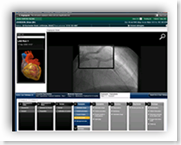Dana Blankenhorn of ZDNet does a nice write up here on his visit to the physician and yes, us “geeks” find our way there too We are probably some of the most curious patients to arrive, as we are looking constantly to see what technology is being used in the medical offices, as it is a known fact that many areas of health care are still a “low” tech business.
 I have written frequently on this exact same issue, integration and capital help for the doctors. Last week I posted about Hoag Hospital here in Newport Beach doing the same thing. What are the elements? A hospital system that is equipped and ready, and two, the support of an integrator or internal integration services to connect and make everything happen and talk to each other.
I have written frequently on this exact same issue, integration and capital help for the doctors. Last week I posted about Hoag Hospital here in Newport Beach doing the same thing. What are the elements? A hospital system that is equipped and ready, and two, the support of an integrator or internal integration services to connect and make everything happen and talk to each other. 
When the hospital calls, and is offering financial support, they are crazy not to listen as it would cost more to go out on your own to accomplish the same. The ultimate fix though is to entertain the Common User Interface, and this way a doctor and staff would pretty much have the same visuals whether it be at a hospital or at the office. With the release of Silverlight 2 yesterday, the green light is on.
I have written much about this same topic in the recent past as well. If vendors could all get together for the user portion of medical records it would certainly make it much easier and promote the adaptation of electronic medical records go much smoother. We certainly have enough free and open source code available so there’s no need to start from scratch and re-invent the wheel at this point and delay the process even further. BD
EHR Adoption Remains Off in the Distance – Getting way to complicated
Microsoft Technology Centers – Software Solutions with Assistance and Guidance
The ability to take advantage of a Microsoft Tech Center is available to help write the code and move forward in this effort, especially with connecting to Amalga. (the story was also featured on Reuters recently)
___________________________
While on the table for my regular check-up my doctor let slip that the practice is getting an Electronic Medical Records (EMR) system early next year.
What kind, I asked? NextGen, she said. How, I wondered? The hospital, she answered.
The key point here is the second one. Hospitals are driving the adoption of EMRs in most medical offices. Alliances between vendors work  only when they can move down the chain, from the big boys to the smaller.
only when they can move down the chain, from the big boys to the smaller.
Key customers are key.
In the case of my doctor, I did some research and found she’s going to be a Windows shop. While offering a nod to platform independence, the Philly-based company (a unit of QSI) generally builds on Microsoft tools.
This means there will be Microsoft HealthVault interoperability and a Microsoft-centric architecture.
I don’t think this matters to her. What matters is that the hospital her practice is attached to is telling her to do this. So she will do this.
It’s an important lesson. In medicine change comes from the top down.
Related Reading:
HealthVault Has New Features Including Fax Services for $9.00 a year – Fax to the Vault!
Going live with Microsoft HealthVault - Chart Integration at the Hospital
Microsoft HealthVault and RelayHealth (McKesson) to Connect Doctors and Patients
Hoag Hospital Selects eClinicalWorks for Its EHR Subsidy Program- Newport Beach, CA
Eclipsys acquisition of Medinotes stands to open doors for Hospital subsidized medical records and integration
How electronic records reach your doctor | ZDNet Healthcare | ZDNet.com



This comment has been removed by a blog administrator.
ReplyDelete